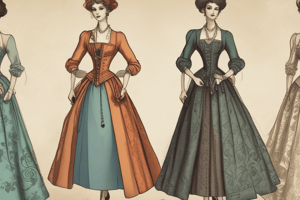Podcast
Questions and Answers
What distinguished the clothing of men and women during the late medieval period?
What distinguished the clothing of men and women during the late medieval period?
- Different types of shoes
- Different lengths of tunics (correct)
- Different styles of hats
- Different colors of fabric
Which material was being extensively used in clothing during the Middle Ages and Renaissance?
Which material was being extensively used in clothing during the Middle Ages and Renaissance?
- Wool
- Leather
- Silk (correct)
- Linen
What technological innovation contributed to women gaining additional freedom in clothing choices?
What technological innovation contributed to women gaining additional freedom in clothing choices?
- Invention of the sewing machine (correct)
- Introduction of cotton as a fabric
- Discovery of synthetic fibers
- Invention of the loom
What marked the eighteenth century in terms of fashion and clothing production?
What marked the eighteenth century in terms of fashion and clothing production?
How did increased wealth impact clothing during the Middle Ages and Renaissance?
How did increased wealth impact clothing during the Middle Ages and Renaissance?
What allowed many more people access to attractive clothing in the Modern Era?
What allowed many more people access to attractive clothing in the Modern Era?
What natural materials were used by early humans for clothing in ancient times?
What natural materials were used by early humans for clothing in ancient times?
Which of the following was one of the primary purposes served by early clothing materials?
Which of the following was one of the primary purposes served by early clothing materials?
What marked the dawn of textile production according to the text?
What marked the dawn of textile production according to the text?
What significant discovery regarding fabrics was found in an Egyptian tomb dating back to 3400 BC?
What significant discovery regarding fabrics was found in an Egyptian tomb dating back to 3400 BC?
Which ancient civilization started using wool instead of linen and spun their own thread on spinning wheels?
Which ancient civilization started using wool instead of linen and spun their own thread on spinning wheels?
Where did looms spin fine threads from cotton fibers outside Egypt according to the text?
Where did looms spin fine threads from cotton fibers outside Egypt according to the text?
Flashcards are hidden until you start studying
Study Notes
Dressing Up: A Brief History of Clothing
Clothing has been around since prehistoric times and is as old as human civilization itself. It's hard to imagine a world without it, yet its history is often overlooked. Here we take a brief look at some key milestones in clothing history.
Ancient Times
In the beginning, people wore little more than leaves, furs, animal skins, and other natural materials. They were adapted from nature and served primarily functional purposes such as protection against cold, heat, wind, rain, insect bites, thorns, prickles, and poisonous plants, and they could also help with camouflage when hunting animals. As time passed, early humans began to experiment with different types of fabric by twisting together plant fibers like flax, hemp, and cotton into yarn before knitting them into simple garments. This progression signaled the dawn of what would become textiles.
Early Civilizations
The first true evidence of woven fabrics comes from an Egyptian tomb dating back to 3400 BC which contained shredded linen sheets that had been woven from flax. By 1700 BC, the Greeks started using wool instead of easily destroyed linen and spun their own thread on spinning wheels with treadle mechanisms for sewing machines. In India, where cotton was cultivated earlier than anywhere else outside Egypt, looms were used to spin fine threads from cotton fibers.
Middle Ages & Renaissance
During this period, clothing became more elaborate due to increased wealth among European societies. However, there was still very little distinction between men's and women's apparel until the late medieval period. For example, both sexes typically wore tunics called 'shift', although those shifts worn by townsmen usually ended just below the knees while noblewomen wore longer versions extending down over their feet. Even softer materials such as silk were being used extensively during this era.
Modern Era
From the eighteenth century onward, fashionable society sought new ways to display status through dress. With industrialization came mass production techniques allowing many more people access to attractive clothing made from cotton and synthetic fibers. Women gained additional freedom thanks partly to the invention of the sewing machine which enabled quick home stitchery—no need for costly ready-made clothes anymore!
In conclusion, though sometimes underappreciated today, history proves humanity's enduring love affair with dressing up: whether for necessity or self-expression; simplicity or lavishness; practicality or luxury - our relationship with how we choose to cover ourselves continues to evolve even now.
Studying That Suits You
Use AI to generate personalized quizzes and flashcards to suit your learning preferences.





